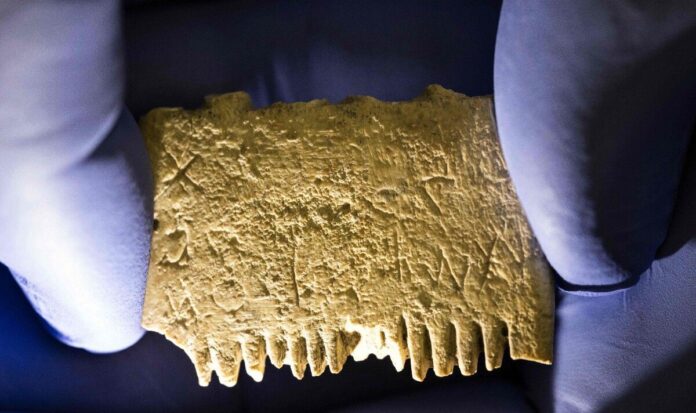Experts have made a stunning breakthrough after unravelling the meaning behind a Canaanite sentence inscribed onto a 3,700-year-old ivory comb for the first time. Researchers, who have hailed the discovery as a “landmark in the history of the human ability to write”, have found out the mysterious meaning behind the inscription which includes 17 letters and seven words engraved onto the artefact. The object was first excavated back in 2017 at Tel Lachish, an archaeological site in Israel, by a research team from the Hebrew University of Jerusalem (HU) and the US-basd Southern Adventist University. But due to the shallow engravings on the ivory comb, the discrete sentence was not actually spotted until 2022 during post-processing.The true meaning of the sentence is, according to experts: “May this tusk root out the lice of the hair and the beard”. Professor Yosef Garfinkel from HU said: “This is the first sentence ever found in the Canaanite language in Israel. There are Canaanites in Ugarit in Syria, but they write in a different script, not the alphabet that is used today.”The Canaanite cities are mentioned in Egyptian documents, the Amarna letters that were written in Akkadian, and in the Hebrew Bible. The comb inscription is direct evidence for the use of the alphabet in daily activities some 3,700 years ago. This is a landmark in the history of the human ability to write.” Experts have deciphered an ancient language inscription on a 3,700-year-old artefact (Image: Getty ) The sentence translates as: ‘May this tusk root out the lice of the hair and beard’ (Image: Getty )The research team undertook an analysis of the comb to determine whether there was a presence of lice under a microscope, and snapped photographs of both sides of the object. They found the remains of head lice, 0.5 to 0.6 millimeters in size, on the second tooth of the comb.But due to the climatic conditions of Lachish, the ancient city the comb would have been used in, the preservation of whole head lice was not possible, only allowing for the outer chitin (polymer) membrane of the so-called nymph-stage head louse.The comb has teeth on both sides and while the bases are still visible, the object’s teeth themselves were broken in antiquity.The central part of the comb has eroded away, which may be due to pressure from fingers holding the comb during haircare or the removal of lice from the hair or beard.READ MORE: Sunak urged to issue ‘Norway-style’ windfall tax to cut energy bills Tel Lachish, an archaeological site in Egypt (Image: Getty )It is thought that, given the material of the comb, it was likely an imported luxury item from somewhere like Egypt.The researcher’s findings were published in the peer-reviewed journal Jerusalem Journal of Archaeology, entitled ‘A Canaanite’s Wish to Eradicate Lice on an Inscribed Ivory Comb from Lachish’. Lachish was an ancient Canaanite and Israelite city that was given mentioned several times in the Hebrew Bible. Up to 10 Canaanite inscriptions have been discovered at the ancient location to date, more than at anywhere else in Israel. Lachish was also the main center for the use and preservation of the alphabet for over 600 years between around 1800 BCE to 1150 BCE, experts suspect. DON’T MISS Rare ‘blood moon’ caught on camera before it disappears for years [REPORT] Astonishing story of how Tutankhamun’s golden treasure tomb was found [REVEAL] National Grid unlocks ‘record breaking’ energy milestone [INSIGHT] The comb has teeth on both sides and the base is still visible (Image: Getty ) Lachish was ancient Canaanite and Israelite city (Image: Getty )The researchers explain in the paper: “Amarna letters are an archive written on clay tablets primarily consisting of diplomatic correspondence between the Egyptian administration and its representatives in Canaan and Amurru or neighboring kingdom leaders, during the New Kingdom, spanning a period of just three decades from 1360 BCE.’ Dr. Daniel Vainstub, an epigrapher from Israel’s Ben Gurion University and lead author of the study, told the Times of Israel, said: “‘the comb’s inscription is written in the style that characterized the very earliest stage of the alphabet’s development.”The inscription’s 17 minuscule 1-to-3 mm pictographic letters get progressively smaller and lower towards the end of the first row. Experts say the engraver then ran out of space at end of the second row before finishing his word, so he engraved another letter on a row below. Experts say that the artefact could be the only preserved example of the now-extinct Hebrew letter ‘sin’, while it may also be the earliest available record of the word ‘tusk’ until its use in Rabbinic Hebrew some 2,000 years later.


